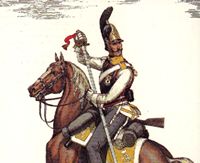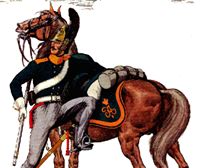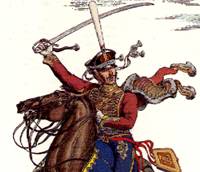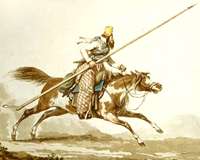|

|
Cuirassiers
 As
in almost all armies, the cuirassiers were the decisive arm
used to break through an enemy through the sheer weight of man
and armour. As
in almost all armies, the cuirassiers were the decisive arm
used to break through an enemy through the sheer weight of man
and armour.
The Russian cuirassiers wore black-enamel curaisses, front and
back, and were, in the early-years of the Napoleonic Wars, armed
with a straight-bladed pallasch. The sword was 82 centimetres
long with a half-basket guard.
In 1809, the Russians replaced the German-based weapon with
a French-style sabre, which was 87 centimetres long and had
a three-bar guard.
Some cuirassiers carried short, rifled carbines for guarding
the flanks during an advance.
In 1803, the Russians discarded the old bicorne hat for their
heavy cavalry and introduced a very tall and distinctive leather
helmet that was crowned by a huge caterpillar mane.
|
|
Dragoons
 After
Tsar Alexander's accession to
the throne, the number of dragoon regiments was increased at the
expense of the cuirassiers. After
Tsar Alexander's accession to
the throne, the number of dragoon regiments was increased at the
expense of the cuirassiers.
Russian dragoons were armed with pallasches, like the heavier
cavalry, but made the switch to the French-style sabre in 1806.
Dragoons also carried muskets and bayonets.
|
|
Hussars
 While
Tsar Paul had set back most of
Russia's military with reactionary ideas, the hussars fared well
under the new ruler. While
Tsar Paul had set back most of
Russia's military with reactionary ideas, the hussars fared well
under the new ruler.
The light-cavalry arm was increased from one regiment to nine
by 1803 and a further two by 1811.
Hussars were armed with curved sabres.
|
|
Cossacks
 Cossacks
made up the majority of Russian horsemen with an estimated 80,000
in service in 1805. Cossacks
made up the majority of Russian horsemen with an estimated 80,000
in service in 1805.
Feared by enemies for their lack of mercy and insatiable greed
for plunder, cossacks were ill-disciplined and not much use against
formed units.
However, when raiding, or harrassing units on the march, they
were in their element.
|
|
|
|
|